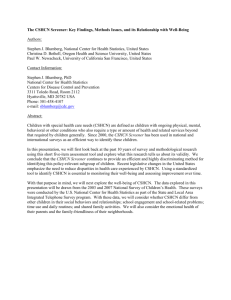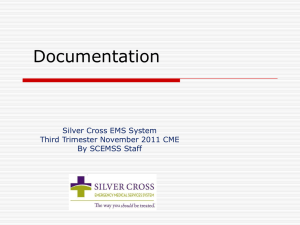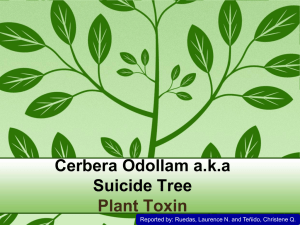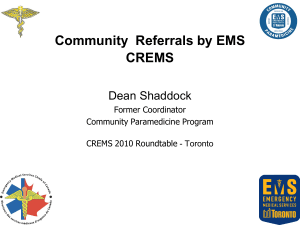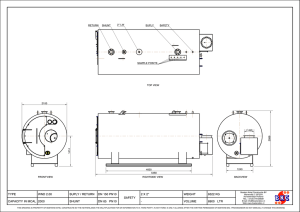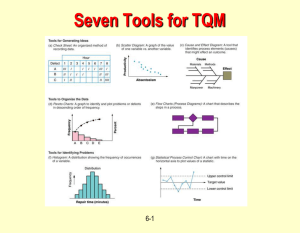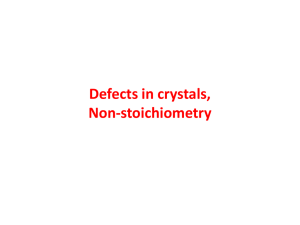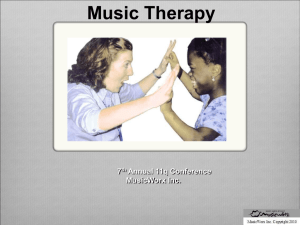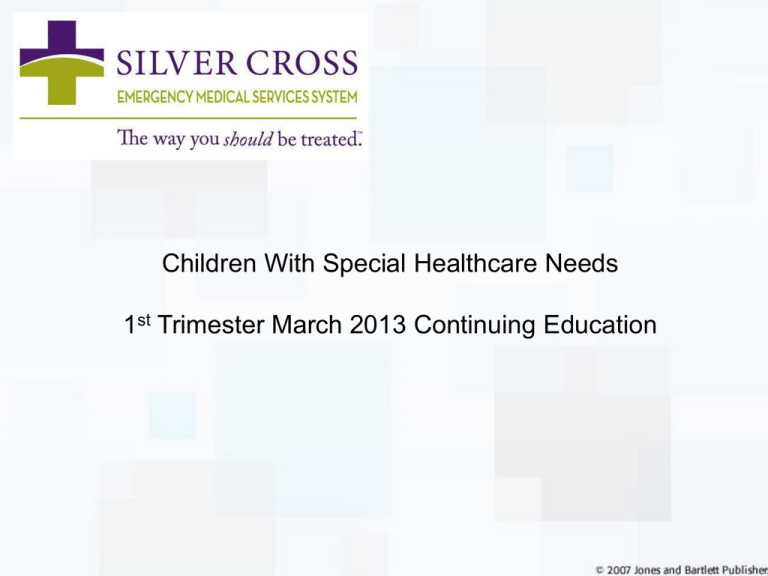
Children With Special Healthcare Needs
1st Trimester March 2013 Continuing Education
Our agenda today
•
•
•
•
•
System announcements
Children with special healthcare needs
Children with special psychiatric needs
(ALS) Strip o’ the month: Bradycardia
(ALS) Drug o’ the month: Atropine
Special thanks to:
The Alameda County
(CA) Public Health
Department
I. Introduction to Children With
Special Health Care Needs
(CSHCN)
CSHCN: Definition
CSHCN (Children with Special Health Care Needs) –
Children who have or are at increased risk for a chronic
condition
– physical
– developmental
– behavioral
– emotional
and who also require health and related services of a type or
amount beyond that are required by children generally.
From: Commentary in Pediatrics, Vol. 102, No.1, July 1998.
CSHCN: Epidemiology
• 12 million US children are considered “special
needs,” which is 18% of all U.S. children
From: 1994 National Health Interview Survey on Disability
• Estimated that 25% of children treated in
pediatric EDs have special needs
From: Pediatric Emergency Care, Vol 12, No. 3 June 1996
CSHCN: Health Care Realities
• Managed Care
– Complicated home care financially
driven
– Parents forced to provide
advanced care
• Societal Changes
– “Family-centered care”
– Disabled have right to be home
• Medical Advances
– Portable technology
– Improved techniques and
medications
CSHCN: Equipment
Technology-Assisted Children
•
•
•
•
•
•
Feeding catheters
Colostomies
Pacemakers
Glucometers
Nebulizers
Apnea monitors
• Tracheostomies
• Ventilators/BiPAP
• Central venous
catheters
• CSF shunts
• Vagal nerve stimulators
CSHCN: Important Points
• Assess and manage ABCs as with any
other child
• Listen to parents/caregivers
– They know problems and treatments very
well
II. Common Chronic Pediatric
Illnesses: Pulmonary Disorders and
Airway Defects
Pulmonary Disorders and Airway
Defects
Apnea
• Definition
– Respirations cease for > 20
seconds or
– Respirations cease for < 20
seconds with cyanosis or
bradycardia
• Causes
– Obstructive, central, or mixed
– Affects both premature and fullterm infants
Pulmonary Disorders and Airway
Defects
Cystic Fibrosis
• Overview
– Affects 30,000 Americans
– Autosomal recessive disorder
– Mucus builds up in lungs
• Signs and symptoms
– Increased respiratory rate
– Increased oxygen requirement
– Paleness or cyanosis
• Management
–
–
–
–
Give active form of the abnormal protein product
Chest therapy with bronchial or postural draining
Antibiotics
Bronchodilators
III. Cardiovascular Defects
Cardiovascular Defects
Congenital Heart Defects (CHDs)
• 1 in 1,000 live births
• Two types
1. Acyanotic
2. Cyanotic
Cardiovascular Defects
Acyanotic Heart Defects
• Account for the majority of CHD in children
• Mixing of desaturated blood in the systemic
arterial circulation
• Oxygen saturation is in the normal range
• Generally septal defects, obstructions to the flow
of blood, and incomplete heart development.
Cardiovascular Defects
Signs/Symptoms of Acyanotic Heart Disease
•
•
•
•
Increased respiratory rate
Increased heart rate
Heart murmur
Signs of heart failure
– Rales on lung exam
– Palpable liver edge
– Swollen extremities
Cardiovascular Defects
Types of Acyanotic Heart Defects
• VSD (most common)
• Ventral Septal Defect
– Defect in wall that separates
ventricles
• ASD
• Atrial Septal Defect
• Patent ductus arteriosus
• Fetal blood passage doesn’t close after
birth
• Obstructive lesions
• Narrows the aorta or valves
Cardiovascular Defects
Cyanotic Heart Defects
• Blood from arteries and veins mix in the heart
• Typical oxygen saturation—70% to 90% on room
air
• Palliative procedures often performed at birth
• Caregivers/medical control may advise that you
avoid administration of O2 unless O2 saturation is
below usual
– Otherwise, never withhold oxygen!
Cardiovascular Defects
Signs/Symptoms of Cyanotic Heart
Disease
•
•
•
•
•
•
Cyanosis
Increased respiratory rate, retractions
Increased heart rate
Poor perfusion
Diminished peripheral pulses
Poor feeding, sweats with feeds
Cardiovascular Defects
Types of Cyanotic Heart Defects
•
•
•
•
•
•
•
Hypoplastic Left Heart Syndrome
Transposition of the great arteries
Tetrology of Fallot
Tricuspid Atresia
Pulmonary Atresia
Truncus Arteriosus
Cardiac Arrhythmias
IV. Down Syndrome
Down Syndrome
Down Syndrome (Trisomy 21)
•
•
•
•
Chromosomal abnormality
Affects 1 in 800 births
Highest risk: women > 35 years
At risk for medical complications of multiple
systems
Down Syndrome
Signs/Symptoms of DS
•
•
•
•
•
•
Large tongue
Short neck
Obesity
Short stature
Loose ligaments
Epicanthal folds
Down Syndrome
Conditions Associated with DS
• Congenital heart disease
– VSD, ASD, AV canal
• Orthopedic conditions
– Atlantoaxial subluxation
• Neurologic Conditions
– Epilepsy
• Airway and Respiratory problems
– Dental and speech abnormalities
V. Traumatically Disabled Children
Traumatically Disabled Children
• Unintentional injuries are the leading cause of
morbidity and mortality
• Traumatic brain injuries
– Risk of seizures
– May need CSF shunt/feeding tube/wheelchair
• Spinal cord injuries
–
–
–
–
Difficulty regulating body temperature
Pressure sores are serious concerns
Disabled child may be unaware he or she is injured
High risk of abuse
VI. Neurologic Diseases
Neurologic Diseases
Causes of Seizures
•
•
•
•
Epilepsy
Traumatic brain injury
Genetic/metabolic defect
Congenital brain abnormality
– Including mental retardation
• Tumor
Neurologic Diseases
Generalized Seizures
• Tonic clonic or grand mal
– Duration seconds to minutes
– Most common type of seizure
• Absence
– Vacant, blank stare
– May occur many times a day
• Myoclonic
– Infantile spasms
– Difficult to control
Neurologic Diseases
Partial Seizures
• Simple partial
–
–
–
–
One part of brain involved
Child awake and aware
Involves one limb or one side of body
Can progress to generalized seizure
• Complex partial
– Child unconscious
– Affects one side of the body
• Psychomotor partial
– Repetitive fine-motor activity
– Most common; one part of the brain
Neurologic Diseases
Management of Seizures
• Antiepileptic medications
– Most common treatment
• Home Valium per rectum
– For frequent and/or prolonged seizures
– Can NOT give unless you are trained to do so and
with approval of medical control
• Vagal nerve stimulators
• Ketogenic diet
– For intractable seizures
Neurologic Diseases
Hydrocephalus
• Excessive build-up of CSF
within the cavities of the brain
• Causes
– Congenital hydrocephalus
(occurs before birth)
– Acquired hydrocephalus
(occurs after birth)
Neurologic Diseases
Management of Hydrocephalus
• CSF shunts
– Ventriculoparietal shunt most common type
• Shunt complications
– Shunt malfunction, obstruction
– Infection
• Signs and symptoms of shunt
malfunction
–
–
–
–
Headache
Nausea/Vomiting
Diminished mental status
Bradycardia, hypertension, irregular
respirations
– “Sundown eyes”
Neurologic Diseases
Mental Retardation
• IQ < 70
• Non-progressive disorder
• Cause is prenatal problem, brain injury, or genetic
syndrome
• Requires special education
Developmental Delay
• Results from prolonged illness or prematurity
• Potential to “catch up”
• Requires special education
Neurologic Diseases
Spina Bifida (Myelomeningocele)
• Failure of the spinal cord to fuse during pregnancy
• Characteristics depends on level of lesion
–
–
–
–
–
–
Paralysis
Hydrocephalus
Delay in motor development
Loss of bladder function/UTIs
Normal intelligence
Considered to have latex allergy
Neurologic Diseases
Cerebral Palsy (CP)
• Characteristics
– Damage to brain center controlling muscle control
– Multiple types
– Congenital or acquired
• Often occurs in very-low-birth-weight babies
– Hypertonic, contracted limbs
– 50% have seizure disorder
– Two-thirds have mental retardation
Neurologic Diseases
Cerebral Palsy
•
•
•
•
•
Management
Braces
Wheelchairs
Oral medications
Baclofen intrathecal pumps
VII. Hematology and Oncology Diseases
Hematology and Oncology
Diseases
Sickle Cell Anemia (SCA)
• An inherited hemoglobinopathy that
causes sickling of RBCs
• Characteristics
–
–
–
–
Pain,“vaso-occlusive crisis”
Splenic sequestration
Aplastic crisis
Sepsis
Hematology and Oncology
Diseases
Hemophilia
• An inherited disorder in which a factor needed for
clotting blood is either too low or missing
• Incidence
–
–
–
–
15,000 in U.S. (mostly males)
60% severe form
15% moderate form
25% mild form
• Characteristics
– Prolonged bleeding
– Factor routinely administered at home
– Seemingly minor injury can be serious
X. Musculoskeletal Disorders
Musculoskeletal Disorders
Osteogenesis Imperfecta
• “Brittle bone” disease
• Incidence: 20,000–50,000 people in U.S.
• Etiology
– Genetic disorder
– Defective collagen synthesis
– Multiple types, differing severity
• Characteristics
–
–
–
–
Bones fracture easily
Weak musculature
Growth retardation
Head disproportionately large for body
Musculoskeletal Disorders
Muscular Dystrophy
• Cause
– Most common type is
Duchenne’s
– Flaw in muscle protein
– Muscle-wasting disease
– Most are inherited
• Characteristics
– Motor skills deteriorate
– Cardiomyopathy
– Shortened lifespan
XI. Tips for Chronic Conditions
Tips for Chronic Conditions
• Medical Identification
Jewelry
• Parents trained in child’s
care
• Often part-time home health
care assistance
• DNR forms—Follow local
protocols
• EMS Outreach Program
• EMS Notification
Courtesy of the MedicAlert Foundation®. © 2006, All Rights Reserved. MedicAlert® is a federally registered
trademark and service mark.
Tips for Chronic Conditions
• Assess and manage ABCs as with any other
child
• Listen to parents/caregivers
• They know problems and treatments very well
A Different Look
Why CSHCN Caregivers Call 9-1-1
• 97 of 100 CSHCN families surveyed have sought
emergency care
• 75 sought emergency care three or more times
• CSHCN require EMS services because:
–
–
–
–
Home health care equipment fails
Caregivers panic
No improvement with therapy
Child in respiratory or cardiac distress/arrest
A Different Look
Differences to Consider
•
•
•
•
Medical issues vs. equipment issues
Atypical baseline vital signs
May be smaller than same age peers
May be developmentally delayed
A Different Look
General Approach
• Ask “What is normal for your child?”
• Respect caregiver’s opinion on child’s condition.
– Many know as much as the doctors do about their child’s
illness.
• Treat the child, not the technology.
• Simple illnesses can be life-threatening .
• Caregivers are experienced with the medical
system.
II. The ABCDEs:
Interventions Using Special
Technology
AIRWAY: Tracheostomies
Airway
Tracheostomy
• An artificial airway passed
through a surgical opening
(stoma) in the anterior
aspect of the neck and into
the trachea
Airway
Tracheostomy Indications:
• To bypass an upper-airway obstruction
• To provide long-term mechanical ventilation
• To facilitate clearance of excess secretions
Airway
Tracheostomy Types and Features
Single
Lumen
Double
Lumen
Fenestrated
Airway
Interventions:
•
•
•
•
Position of comfort
Humidified air or O2
Nebulized 1:1000 epinephrine, if protocols allow
If child is in extremis, consider endotracheal
intubation
Airway
Alleviating Respiratory Distress
•
•
•
•
•
Position
Suction
Oxygen
Repeat
An emergency tracheostomy tube change
may be necessary.
Airway
When to ventilate manually
• Upon removal from ventilator
• Consider before/after
suctioning or trach change
• Signs of respiratory distress or
failure
Airway
Causes of Tube Obstruction
• Improper airway positioning
• Improper insertion of the trach tube
– Creation of a “false track”
• Mucous plug
• Failure to remove obturator after tube insertion
Breathing
Interventions
•
•
•
•
Disconnect patient from the ventilator
Began manual ventilation
Assess for chest rise, breath sounds
If no improvement, check for tracheostomytube obstruction
• If improved, consider ventilator issue
• Prepare for transport
CIRCULATION: Central
Venous Catheters
Circulation
Purpose of Central Venous Catheters
•
•
•
•
•
Administration of Medications
Delivery of chemotherapy
Nutritional support
Infusion of blood products
Blood draws
Circulation
Types of Catheters
• Broviac, Hickman, Groshong
-Tunneled central venous catheters
- Proximal tip in the subclavian vein
- External access
• Port-a-Cath/Med-a-Port/PAS Port
- Catheter system is completely beneath skin
• Percutaneous Intravenous Catheter (PICC)
- Proximal tip in central vein
- Looks like a PIV
DISABILITY
Disability
Interventions
•
•
•
•
•
Position
Oxygen
Maintain body temperature
ALS: IV, fluids, IO
ALS: Consider inotropes for shock if
unresponsive to fluid resuscitation
Assessment of neurological status
• Ask caregiver to compare child’s present
status to baseline
Disability
Cause of symptoms:
• Shunt infection
– If child presents with a fever or redness along the
shunt tubing, suspect a shunt infection
• Meningitis
• Encephalitis
Disability
CSF Shunts
• A CSF shunt is a catheter with one end in a
ventricle of the brain and the other end in the
abdomen or atrium that drains excess CSF or
bypasses a blockage of CSF.
Types:
• Ventriculoperitoneal
• Ventriculoatrial
Disability
Concern
• The shunt could be damaged or
disconnected. This can result in increased
intracranial pressure.
Disability
Causes of Complications:
• Brain infection
• Shunt obstruction (resulting in a
dangerous build-up of fluid in the skull)
• Shunt malfunction
• Peritonitis
Children with Special Healthcare Needs
• Cerebrospinal fluid shunts
– Emergency care
•
•
•
•
•
•
Vomit, aspiration
Suction
O2
Assist breathing, intubate
Blood sugar
Treat seizures
Children with Special Healthcare Needs
Shunt Drainage Routes
Children with Special Healthcare Needs
External Shunt Infection
EXPOSURE
Exposure
Interventions
• Assess neurovascular status distal to the
injury.
• Gently place on a long-board splint.
• Avoid taking the blood pressure of a child with
osteogenesis imperfecta.
• Do not use a hare traction splint or MAST
trousers.
IMPORTANT POINTS
• Cover the child to maintain normal body
temperature
• Respect the child’s privacy
IMPORTANT POINTS
• Carefully examine for injuries
– Assessment may be difficult due to
developmental level
– CSHCN are at high risk for abuse
• Report any suspicious injuries
to the proper agency.
II. SAMPLE History:
Feeding Catheters
Feeding Catheters
• Nasogastric Tube (NGT):
– Catheter placed through the nose into
stomach
– For supplementation in children who
cannot take enough by mouth
– Short-term use
– Can use to decompress stomach
Feeding Catheters
•
Gastrostomy
Feeding Tube (GT):
– Catheter surgically or
endocopically placed
into stomach or
Jejunum
– Provides long-term
nutritional support
Feeding Catheters
• Feeding Catheter
Complications:
– Gastric contents can leak, causing
irritation
– Tube obstructed
– Tube dislodged
– Abdominal distention
I. Moving Children with
Special Needs
Communication
• Challenges:
– Language barriers
– Is the person with the
child the primary
caregiver?
– Assess child’s ability to
understand.
• Developmental delay
• Visual/auditory deficits
Communication
•Management:
– Use a soothing voice to provide comfort.
– Explain each movement.
– Ask the caregiver for a medical summary
card. Oftentimes, the caregiver may be
too stressed to remember vital
information.
Environment
•Challenges:
– The scene and the child’s
response to that environment
can be a great source of tension
and anxiety.
– Multiple providers can create
fear.
– Multiple voices can cause
confusion.
Environment
• Management:
– Limit the number of providers.
– Ask one person to speak and interact
with the child.
– Decrease chaos.
– Keep the noise down.
TRANSPORT AND TRANSFER
Transport
•Challenges:
– Anxiety in child.
– Child may resist being restrained.
– Brittle bones and muscle contractures
can easily lead to injuries during
transport.
– Do not pull on extremities!
Transfer
• Management
– Make secure, firm contact
– Suggest that family member move
child.
– Allow the child to lay in a comfortable
position.
– Use padding around buckles and
contractures.
– Do not pull on extremities!
Stabilization
• Secure and transport child in own
special restraint device if:
– No suspicion of cervical injury.
– Child is not critically ill.
– Device doesn’t impede assessment and
treatment.
– Device can be properly secured in
ambulance.
Destination Decisions
• Challenges:
– Parents’ confidence in EMS system*
• 82% very confident in EMS care and home
hospital
• 77% uneasy/not confident in community
hospital care
• 98% very confident in “home” hospital care
• Parents trust 9-1-1 but not 9-1-1 transport decisions!
*100 CSHCN families surveyed in 2000
Children with Special Behavioral
and Emotional Needs
• Behavioral emergencies involving children present
special challenges to EMS.
• Aggressive behavior may really be symptom of an
underlying disorder or disability.
• Parents of mentally ill children often overwhelmed
and isolated from community and social support
network.
• Family may hesitate to call 911 because of fear of
stigma or misinterpretation by EMS personnel.
EMS Response
• Volatile situations require shift from common EMS
response to integrated community collaboration and
adaptive “out-of-the-box” decision making.
• 911 call may be from a mother or school staff member
desperate for help with “out-of-control” child.
• Immediate link to pediatric or mental health
professionals may de-escalate the child’s psychiatric
emergency and ensure continuity of care.
• Unfortunately many EMS system policies, procedures,
guidelines, and training do not include these options.
Common Behavioral
Emergencies in Children
• Major psychiatric disorders that may predispose
to behavioral emergencies in children include
–
–
–
–
mood disorders (e.g., depression, bipolar disorder);
thought disorders (e.g., schizophrenia);
developmental disorders (e.g., autism);
anxiety disorders (e.g., posttraumatic stress
disorder);
– other disorders such as attention deficit hyperactivity
disorder.
EMS considerations
• EMS can assist and advocate for child and the family
during a behavioral emergency.
• Family of a child with behavioral problems lives in
fear of restraints, hospitalizations, false accusations.
• Understanding emotional fatigue, physical
exhaustion, and chronic life disruptions of families is
is integral to addressing their needs.
EMS Considerations
• Families of children with psychiatric disorders
often have competing fears:
– Love for their child
– Fear of a violent outburst by the child toward the family
– Fear of the violence that may occur if the child needs
to be restrained by the police or EMS providers.
For more information on pediatric
psych issues and EMS response:
• http://www.acphd.org/media/109325
/meeting_challenges_pediatric_beh
avioral_emergencies.pdf
Rhythm O’ the Month
• Bradycardia
Dysrhythmias Originating
in the SA Node (2 of 10)
Rules of Interpretation
Sinus Bradycardia
Rate
Rhythm
Pacemaker Site
P Waves
Less than 60
Regular
SA node
Upright and normal
PRI
Normal
QRS
Normal
Sinus Bradycardia - Causes
• Decrease in sympathetic tone on the AV
node (increase in parasympathetic tone)
• Pressure on fontanels in infants
• Intracranial swelling
• Glottic irritation from ET tubs, gagging,
emesis
• Disease of the SA node
• Hypothermia, Hypoxia
Sinus Bradycardia
• Administration of digitalis,
propranolol (Inderal), verapamil, and
quinidine
• Common in acute inferior AMI Involves the right coronary artery
which supplies the SA node with
blood
Sinus Bradycardia in Children
• Life threatening, especially in newborns
and infants.
• Often a respiratory issue
– Newborn
• Dry, stimulate, suction first
• Then oxygen, ventilation
• CPR if heart rate remains under 60
– Babies/children
• Treat respiratory issues unless child has known
cardiac issue
Sinus Bradycardia
Treat the patient, not the monitor!
Bradycardia is also common during
sleep, rest and in trained athletes!
Sinus Bradycardia
• Ultimate clinical significance…..
– Decreased heart rate/BP which leads
to decreased CARDIAC OUTPUT
Sinus Bradycardia
• Treatment Modalities
– Asymptomatic – pulse and adequate
BP (>100 systolic)
Routine Medical Care
IV, O2, monitor
Position of Comfort
Sinus Bradycardia
• Symptomatic
– Hemodynamic Instablity (BP <100
systolic)
•
•
•
•
Syncope, hypotension, altered mentation
Chest pain, palpitations, diaphoresis
Difficulty in breathing
Poor skin vitals and perfusion
Symptomatic Bradycardia - ALS
• Do not delay pacing while getting ready for
Atropine
• Pace at 70.
– Increase MA until pulse matches.
• While pacing, consider Versed, 2.5 mg
slow IVP.
• If necessary, Dopamine to maintain SBP
90-105 and pulse >60.
Sinus Bradycardia
• Hypotension
– Leads to decreased cardiac output
– Palpitations
• Because of SA node’s increased relative
refractory period permits refractory firing
Sinus Bradycardia
– Chest Pain
• Heart disease already exists
• Coronary blood flow is decreased
Sinus Bradycardia
• Bottom Line: TREAT THE
UNDERLYING CAUSE TO
ABOLISH THE DYSRHYTHMIA
AND INCREASE THE RATE
Drug O’ the Month
• Atropine!
Atropine Indications
• Symptomatic bradycardia.
• NO LONGER USED: asytole or
PEA
• Nerve agent exposure
• Organophosphate poisoning
Adverse Reactions
• Dry mouth, hot skin, intense facial
flushing
• Blurred vision or dilation of the pupils with
subsequent photophobia
• Tachycardia
• Restlessness
• May cause paradoxical bradycardia if the
dose administered is too low or pushed
to slowly
Contraindications
•
•
•
•
•
Acute MI
Myasthenia Gravis
GI Obstruction
Closed angle glaucoma
Known sensitivity to atropine,
belladonna alkaloids or sulfates
(NOT sulfa)
How Atropine Works
• Increases firing of the SA node.
• Increases conduction through the
AV node.
• Opposes the action of the vagus
nerve.
• Blocks acetylcholine receptor sites
• Decreases bronchial secretions.
Atropine Dosage
Symptomatic Bradycardia
• Adult: 0.5 mg IV/IO every 3 to 5 minutes to a
max dose of 0.04 mg/kg. Don’t delay pacing
for Atropine.
• Peds: Oxygen/ventilation first. Then Epi! If
that doesn’t work then 0.02 mg/kg (min of 0.1
mg/dose; max of 0.5 mg/dose).
– Repeat once in 5 minutes
Dosage
Nerve Agent or Organophosphate
Poisoning
• Adult: 2 mg IVP repeated if needed
every 5 minutes until symptoms
dissipate
• Peds: 0.02 mg/kg IV/IM every 5
minutes as needed until symptoms
dissipate
Questions? If you are watching live,
feel free to type in the text box to
your right.
Special Children,
Special
Care
If you are watching the recording, or
the Powerpoint, feel free to email
afinkel@silvercross.org or call 815300-7130.

